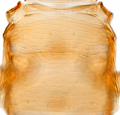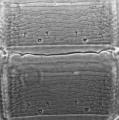Aptinothrips stylifer
Recognition data
Distinguishing features
Both sexes without wings. Body and legs yellow, antennal segments VI – VIII shaded brown, also apex of abdomen. Antennae 8-segmented; segment VI pedicilate, 1.5 times as long as V; segments III–IV with sensorium simple. Head and pronotum without long setae; head longer than wide, ocelli not developed. Meso & metanota transverse. Tarsi 2-segmented. Abdominal tergites and sternites with no posteromarginal craspedum; tergites without discal setae; tergite IX posteromedian setae about 0.6 times as long as lateral pair of setae; sternites with many discal setae.
Male similar but smaller; sternites without pore plates; tergite IX with 2 pairs of stout thorn-like setae.
Related and similar species
Four species are recognized in this European genus (Palmer, 1975; zur Strassen, 2003). These are all completely wingless, but differ in the number of antennal and tarsal segments, and also in details of the chaetotaxy on the tergites and sternites. Two of the species are known only from Eurasia, but both A. rufus and A. stylifer are more widely distributed around the world. A. rufus has the antennae 6-segmented and the tarsi with only one segment. Stannard (1968) refered to A. stylifer as the "stylifera-form" of A. rufus.
Taxonomic data
Current valid name
Aptinothrips stylifer Trybom
Original name and synonyms
- Aptinothrips stylifer Trybom, 1894: 43
Family placement
Thripidae, Thripinae
Biological data
Life history
Feeding and breeding on leaves.
Host plants
Various grasses (Poaceae), with an apparent preference for slender-leaved species of grass.
Tospoviruses vectored
None
Crop damage
None recorded.
Distribution data
Area of origin
Europe
Distribution
Widespread in northern latitudes, also in New Zealand.







